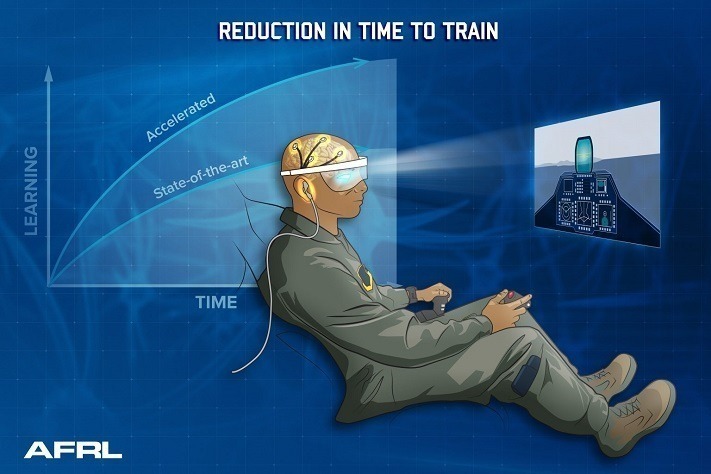Air Force announces research platform to harness closed-loop neurotechnology and accelerate learning “on the fly”

U.S. Air Force illustration/Richard Eldridge
Air Force Neurotechnology Partnership Aims to Accelerate Learning (Military Spot):
The Individualized Neural Learning System, or iNeuraLS, is a new augmented learning platform that will enable rapid learning by closed-loop modulation of cognitive states during skill acquisition. Essentially, the AFRL team seeks to develop a capability that will give Airmen the ability to rapidly acquire knowledge and skills on the fly through direct brain interfaces with the help of neurotechnologies…
“We’re going to have unprecedented access to the brain using a novel brain-machine interface,” said Dr. Nathaniel Bridges, AFRL research biomedical engineer and Neural Interface team lead. He added that these neural signals will be used to develop algorithms that will help researchers determine the optimal brain state under which individuals can receive information. From there, the team will determine the most effective means of enhancing the subjects’ ability to intake and process information. This could range from non-invasive neuromodulation—or brain stimulation—techniques to the use of augmented reality to alter perceived environmental conditions.
Bridges reiterated that this process is not as otherworldly as it may seem. To gather data on brain activity, the team will develop a hybrid brain-machine interface using a combination of two well-established, non-invasive technologies: electroencephalography, commonly known as EEG, and magnetoencephalography, or MEG. He explains that each technology offers its own advantages. Part of the information generated by neuronal currents in the brain is represented as electric fields, which are picked up by EEG, while the other part is represented as magnetic fields, which is picked up by MEG. Additionally, MEG allows for a higher spatial resolution compared to EEG. Therefore, a hybrid of the two technologies would allow researchers to gather information on brain activity quickly, and pinpoint exactly where the activity is occurring within the brain. The researchers will gather this data while a human subject is under different stages of learning and different variables such as fatigue, attention and memory.
About the Project:
- Description: The Air Force Research Laboratory-led Individualized Neural Learning System project aims to give Airmen the ability to rapidly acquire knowledge and skills through neurotechnology. This project was recently awarded funding as part of the Seedlings for Disruptive Capabilities Program, which seeks to “seed” new ideas of particular interest to the Air Force. For more information, visit www.AFResearchLab.com.
News in Context:
- DARPA launches Targeted Neuroplasticity Training program to accelerate cognitive skills training
- Eight research teams working with DARPA to discover best ways to activate neuroplasticity and accelerate learning
- Neurotechnology can improve our lives…if we first address these Privacy and Informed Consent issues
- Researchers stress need for neurotechnologies to protect the mental dimension of individuals and groups, especially mental privacy and integrity


